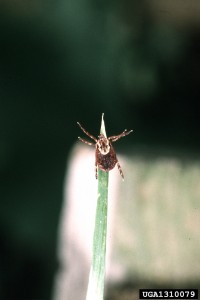Ticks are disgusting, but don’t take our word for it. Aristotle, Cato, and Pliny all referred to ticks as “disgusting parasites”.
Ticks are a public health risk because they feed on the blood of humans and other animals and can transmit several diseases, including Lyme disease. These tiny, blood-feeding arthropods are more closely related to spiders and mites than insects. With wide host-ranges, ticks can be found in many environments – shorelines, forests, farms, fields, and playgrounds. On school and child care facilities, they may be found on fields and play yards located in and around wooded areas, paths, and cross-country trails.
Did You Know…?
- By the numbers: There are 671 species of hard-bodied ticks and 167 species of soft-bodied ticks worldwide. There are four major species of ticks in New York.
- Frost resistant: As long as the temperature is above freezing, ticks can be on the move. Even on those warm January days, be sure to protect yourself from ticks.
- No jumping, dropping, or flying: Ticks quest, which means they stand at the tips of grass or ends of branches and wave their front claws in the air, waiting for something to brush by.
- Taking their time: Finding a tick on a child is not proof that the tick came from the school or child care property. Ticks can take a while before they start attaching, and then can take another two hours to insert their mouthparts.
- Tweezers are best! Use fine-pointed tweezers to grab the tick as close to the skin as possible and pull straight up until the tick releases. Grab it too high, or using other methods such as matches, nail polish, or petroleum jelly, could irritate it, causing it to regurgitate its disease ridden stomach contents directly into your blood stream.
Awareness and a little precaution can help you steer clear of tick-borne illness and the discomfort of being bitten by ticks. See our Understanding and Managing Ticks – A Guide for Schools, Child Care and Camps fact sheet for more information on ticks and how to manage them at your school or child care.

